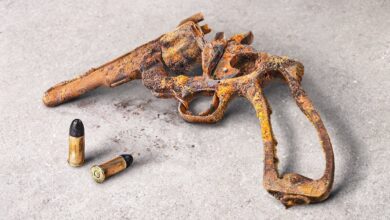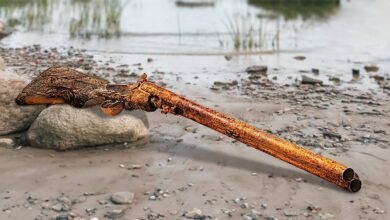Restoring the MG-34: A Legendary Machine Gun
The MG-34, a machine gun that has earned its place in history, was one of the most influential weapons of its time. First introduced by Nazi Germany during the late 1930s, it became one of the iconic infantry weapons of World War II. Despite its initial popularity and efficiency, many MG-34s were either destroyed during the war or decommissioned over the years. For collectors, history enthusiasts, and firearms experts, the restoration of an MG-34 is not just about bringing an old weapon back to life, but also about preserving a significant piece of military history.

A Brief History of the MG-34
Developed in the early 1930s by the German company Rheinmetall, the MG-34 was designed to be a versatile and reliable machine gun. It was one of the first to be capable of sustained fire with a high rate of fire, typically between 800 to 1,200 rounds per minute. The MG-34 was notable for its ability to be used in a variety of roles, including as a light machine gun, a mounted machine gun on vehicles, and even as a fixed anti-aircraft weapon.
What made the MG-34 particularly revolutionary was its ability to be air-cooled, unlike many other machine guns of the time that required water cooling. It utilized a belt-fed mechanism, which allowed for greater firepower and continuous fire in combat. Its design became a precursor to future German machine guns, most notably the MG-42, which was even more influential in shaping the future of machine gun technology.
The MG-34 saw extensive use throughout World War II, but it also had drawbacks. It was complex and costly to produce, and over time, it was replaced in the frontlines by the faster and more efficient MG-42. However, the MG-34 remains an important piece of military engineering and history, and interest in restoring it continues to this day.
Challenges in MG-34 Restoration
Restoring an MG-34 is no easy task. As with any historical firearm, the process requires careful attention to detail, skilled craftsmanship, and a thorough understanding of the weapon’s original design. The MG-34 is a complex machine, composed of many parts that were precision-engineered to function together. Over time, especially after decades of disuse or improper storage, these parts can suffer from corrosion, wear, and misalignment.
Here are some of the primary challenges faced by restorers when working on an MG-34:
- Finding Original Parts: Given that the MG-34 was produced in the 1930s and 1940s, many of the original parts are no longer available. Restorers often have to search through private collections, specialized dealers, and gun shows to find authentic components. This scarcity drives up the price of restoration, making it a costly project.
- Rust and Corrosion: Due to its age and the conditions in which many MG-34s were stored or used, rust and corrosion are common problems. These must be carefully removed without damaging the underlying metal, often requiring professional cleaning and sometimes re-machining of parts.
- Rewelding and Machining: If the weapon has been disassembled or damaged beyond repair, parts may need to be welded or machined to restore their original functionality. This requires both skill and precision, as the MG-34’s complex design must be returned to its exact specifications.
- Restoring the Finish: The MG-34 was originally finished with a blue or blackened finish, and over time, this finish wears off or fades. Restorers often need to apply new coatings that are both historically accurate and protective against future wear and corrosion.
- Functionality Testing: The ultimate goal of restoring the MG-34 is not only to make it look good but to make it function as it was originally designed. This includes ensuring the cycling of the gas system, recoil operation, and magazine feeding are all operating correctly. Test firing the gun in a safe environment is a necessary part of the restoration process.
Restoration Process
The restoration of an MG-34 is typically a multi-step process, involving both cosmetic repairs and functional restoration. Here’s a rough outline of how it’s done:
- Disassembly: The first step is to take the machine gun apart to assess the condition of each part. This process involves separating the receiver, barrel, feed mechanism, and other components. Any parts that are broken, heavily rusted, or missing will need to be replaced or repaired.
- Cleaning: After disassembly, the individual parts are thoroughly cleaned. Rust is carefully removed using specialized cleaning methods like sandblasting or chemical stripping. Parts are also degreased to remove old lubricants and dirt that have accumulated over the years.
- Repairs: After cleaning, any damaged or worn-out components are repaired. This may include fixing cracks in the receiver or re-machining parts that are no longer to spec. Missing components may be fabricated or sourced from other MG-34s.
- Reassembly and Function Testing: Once all parts are repaired or replaced, the MG-34 is reassembled. The machine gun is then tested to ensure all functions work as expected. This includes checking the cycling mechanism, trigger mechanism, and feeding system. Any issues that arise during testing must be addressed before moving on.
- Finishing: The final step in the restoration process is to restore the finish of the MG-34. The metal is treated to prevent future rust and then refinished to match the original look, which is often a matte black or blue-black finish. The wood on the stock and other parts is also refinished or replaced to ensure that the gun retains its historical appearance.
The Importance of Restoring the MG-34
Restoring an MG-34 goes beyond the mechanical work—it’s about preserving history. For many collectors, owning a restored MG-34 is a way to connect with the past, to understand the technological advancements of the 20th century, and to appreciate the sacrifices made by those who used these weapons in battle.
A well-restored MG-34 can be a valuable piece for military museums, historical exhibitions, and private collections. It serves as a tangible reminder of the technological and strategic innovations that took place during World War II. By restoring these machines, enthusiasts ensure that future generations can learn from and understand this crucial piece of military history.
Conclusion
The MG-34 is an iconic machine gun, a symbol of innovation during a turbulent period in history. Its restoration is a delicate and challenging process, requiring technical expertise and a deep understanding of the weapon’s design and history. By breathing new life into these relics of the past, restorers are preserving a key element of military history, ensuring that future generations can appreciate and learn from this remarkable piece of engineering.
For anyone interested in firearms, military history, or mechanical craftsmanship, restoring an MG-34 is not only a rewarding challenge but also a way to contribute to the preservation of one of the most important weapons of World War II.





